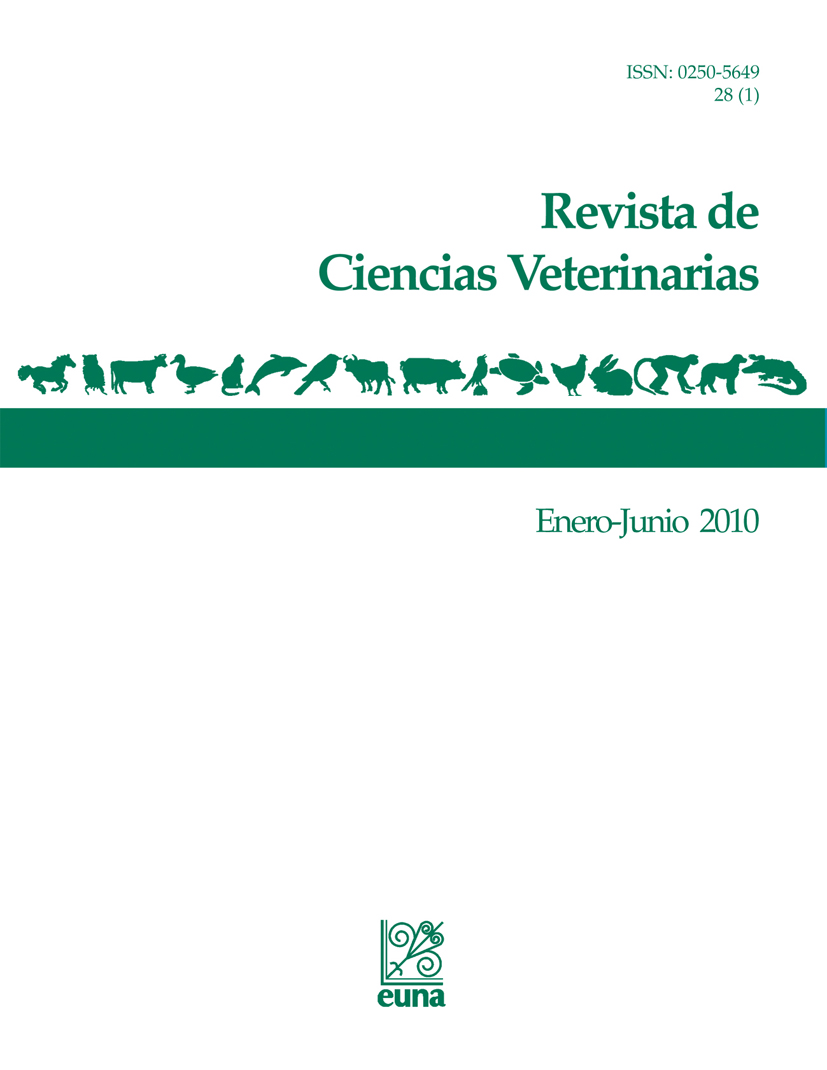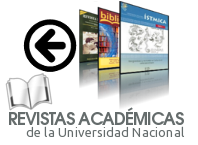Factors associated with twin births in cows from specialized dairy farms in Costa Rica
Keywords:
Reproduction, tropics, cattle, epidemiologyAbstract
The aim of this study was to determine the individual and environmental factors associated to twin birth (TB) in cows from specialized dairy farms in Costa Rica. A descriptive and case-control study was conducted of lactations recorded in the VAMPP Bovino information system between 1994 and 2009. Factors associated to TB were assessed in three steps: 1) descriptive statistics (frequencies and means with 95% confidence intervals), 2) comparisons of means (Student’s T-Test) and percentages (Chi-Square Test), and 3) odds ratio calculation using a logistic regression with random effects. The global TB percentage was 1.02%, without increasing or decreasing tendencies during the analyzed period. Holstein cows had the highest percentage, showing twice the risk of TB compared to other breeds. Cows with high 305-day milk yield showed 1.6 times the risk of TB (CI95%: 1.3–1.9) when compared to low production cows; similarly, cows with more than 6 lactations showed the highest risk of TB (OR= 5.0; CI95%: 3.7–6.7). In addition, it was determined that cows with placental retention had 5.3 times the probability of TB in the next parity (CI95%: 4.2–6.8), while cows with ovarian cysts showed a higher risk of TB (OR= 2.3, CI95%: 18–2.9). The TB frequency in Costa Rican dairy farms is similar to the one reported worldwide in specialized dairy farms, and risk factors found correspond to the ones reported in the literature. Knowing these risk factors contributes to reducing TB frequency in dairy herds and the negative impact attributable there to in several studies.
References
Andreu-Vázquez, C., I. Garcia-Ispierto and F. López-Gatius. 2012. Manual Rupture versus Transvaginal Ultrasound-guided Aspiration of Allanto-amniotic Fluid in Multiple Pregnancies: A Clinical Approach to Embryo Reduction in Dairy Cattle. J. Reprod. Dev. 58(4):420-424.
Andreu-Vázquez, C., I. Garcia-Ispierto, M. López-Béjar, N. M. de Sousa, J. F. Beckers and F. López-Gatius F. 2011. Clinical implications of induced twin reduction in dairy cattle. Theriogenology. 76:512-521
Beerepoot, G. M. M., A. A. Okhuizen, M. Mielen. and Y.H. Schukken. 1992. The economics of naturally occurring twinning in dairy cattle. J. Dairy Sci. 75: 1044-1051.
Bell, M. and D. Roberts. 2007. Effect of twinning on the feed intake, performance and health of dairy cows. Livestock Sci. 107: 274-281.
Bicalho, R. C., S. H. Cheong, K. N. Galvão, L. D. Warnick and C. L. Guard. 2007. Effect of twin birth calvings on milk production, reproductive performance, and survival of lactating cows. J. Am. Vet. Med. Assoc. 231:1390-1397.
Buoen, L. C., T. Q. Zhang, A. F. Wever and G. R. Ruth. 1992. Non-freemartin rate in Holstein heterosexual twins. Am. Assoc. Bov. Pract. Confr.1:300-303.
Cady, R. A. and L. D. Van Vleck. 1978. Factors affecting twinning and effects of twinning in Holstein dairy cattle. J. Anim. Sci. 46:950-956.
Day, J. D., L. D. Weaver and C. E., Franti. 1995. Twin pregnancy diagnosis in Holstein cows: Discriminatory powers and accuracy of diagnosis by transrectal palpation and outcome of twin pregnancies. J. Can. Vet. 36:93-97.
Dubuc, J., T. F. Duffield, K. E. Leslie, J. S. Walton and S. J. LeBlanc. 2010. Risk factors for postpartum uterine diseases in dairy cows. J. Dairy. Sci. 93:5764-5771.
Echternkamp, S. E. and K. E. Gregory. 1991. Identification of twin pregnancies in cattle by ultrasonography. J. Anim. Sci. 69 (Suppl 1):220.
Echternkamp, S. E. and K. E. Gregory. 1999. Effects of twinning on gestation length, retained placenta, and distocia. J. Anim. Sci. 77:39-47.
Echternkamp, S. E. and K. E. Gregory. 2002. Reproductive, growth, feedlot, and carcass traits of twin vs single births in cattle. J. Anim. Sci. 80:1-10.
Echternkamp, S. E., A. J. Roberts, D. T. Lunstra, T. Wise and L. J. Spicer. 2004. Ovarian follicular development in cattle selected for twin ovulations and births. J. Anim. Sci. 82:459-471.
Echternkamp, E., R. A. Cushman, M. F. Allan, R. M. Thallman and K. E. Gregory. 2007. Effects of ovulation rate and fetal number on fertility in twin-producing cattle. J. Anim. Sci. 85:3228-3238.
Eddy, R.G., O. Davies and C. David. 1991. An economic assessment of twin births in British dairy herds. Vet. Rec. 129:526-529.
Erb, R. E. and R. A. Morrison. 1959. Effects of twinning on reproductive efficiency in a Holstein-Friesian herd. J. Dairy Sci. 42: 512-519.
Fricke, P. M., J. N. Guenther and M. C. Wiltbank. 1998. Efficacy of decreasing the dose of GnRH used in a protocol for synchronization of ovulation and timed AI in lactating dairy cows. Theriogenology. 50:1275-1284.
Fricke, P. M. and M. C. Wiltbank.1999. Effect of milk production on the incidence of double ovulation in dairy cows. Theriogenology. 52:1133-43.
Fricke, P. M. and R. Shaver. 2000. Managing reproductive disorders in dairy cows. [en línea] NDSU Extension Service. North Dakota. Consultado 23 Julio 2012. http://babcock.wisc.edu/sites/default/files/documents/productdownload/du_603.en_.pdf
García-Ispierto, I., F. López-Gatius, P. Santolaria, J. L. Yániz, C. Nogareda and M. López-Béjar. 2007. Factors affecting the fertility of high producing dairy herds in northeastern Spain. Theriogenology. 67:632-638.
Garverick, H. A. 1997. Ovarian follicular cysts in dairy cows. J. Dairy Sci. 80:995-1004.
Ghavi Hossein-Zadeh, N., A. Nejati-Javaremi, H. Kohram. 2008. An observational analysis of twin births, calf stillbirth, calf sex ratio, and abortion in Iranian Holsteins. J. Dairy Sci. 91:4198–4205.
Ghavi Hossein-Zadeh, N. and M. Ardalan. 2011. Cow-specific risk factors for retained placenta, metritis and clinical mastitis in Holstein cows. Vet. Res. Commun. 35:345-54.
Gregory K. E., S. E. Echternkamp, G. E. Dickerson, L. V. Cundiff, R. M. Koch and L. D. Van Vleck. 1990. Twinning in cattle: III. Effects of twinning on dystocia, reproductive traits, calf survival, calf growth and cow productivity. J. Anim. Sci. 68:3133-3144.
Grunert, E. y M. Berchtold (eds.)1988. Infertilidad en la vaca. Editorial Hemisferio Sur. Argentina.
Hayes, E.P., R. M. Christley and H. Dobson. 2012. Effects of periparturient events on subsequent culling and fertility in eight UK dairy herds. Vet. Rec. 170:540.
Kinsel, M., W. Marsh, P. Ruegg and W. Etherington. 1998. Risk factors for twinning in dairy cows. J. Dairy Sci. 81:989–993.
Marcusfeld, O. 1987. Periparturient traits in seven high dairy herds. Incidence rates, association with parity, and interrelationships among traits. J. Dairy Sci. 70:158-166.
Marcusfeld, O. 1993. Parturition disease complex do the high yielding dairy cow. Acta Vet. Scand. 89 (Suppl.):9-15.
Nielen, M., Y. Schukken, D. Scholl, H. Wilbrink, H. and A. Brand. 1989. Twinning in dairy cattle: a study of risk factors and effects. Theriogenology. 32:845–862.
Noordhuizen, J.P.T.M. and J. Buurman, 1984. Veterinary automated management and production control programme for dairy farms (VAMPP), the application of MUMPS for data processing. Vet. Quarterly. 6:62-77.
Pfau, K.O., J. W. Bartlett and C. E. Shuart. 1948. A study of multiple births in a Holstein-Friesian herd. J. Dairy. Sci. 31:241-254.
Ryan, D. P. and M. P. Boland. 1991. Frequency of twin births among Holstein-Friesian cows in a warm dry climate. Theriogenology. 36:1-10.
SAS Institute.1990. Procedures guide. Version 6. 3 rd. ed. Cary, NC, U.S.
Silva del Rio, N., J. D. Colloton and P. M. Fricke. 2009. Factors affecting pregnancy loss for single and twin pregnancies in a high-producing dairy herd. Theriogenology. 71:1462-71
Stevenson, J. S. and E. P. Call. 1988. Reproductive disorders in the periparturient dairy cow. J. Dairy Sci. 71:2572-2583.
Wiltbank, M. C., P. M. Fricke, S. Sangsritavong, R. Sartori and O. J. Ginther. 2000. Symposium: Physiology, lactation and reproduction mechanisms that prevent and produce double ovulations in dairy cattle. J. Dairy Sci. 83:2998-3006.
Downloads
Published
How to Cite
Issue
Section
License
Licensing of articles
All articles will be published under a license:

Licencia Creative Commons Atribución-NoComercial-SinDerivadas 3.0 Costa Rica.
Access to this journal is free of charge, only the article and the journal must be cited in full.
Intellectual property rights belong to the author. Once the article has been accepted for publication, the author assigns the reproduction rights to the Journal.
Ciencias Veterinarias Journal authorizes the printing of articles and photocopies for personal use. Also, the use for educational purposes is encouraged. Especially: institutions may create links to specific articles found in the journal's server in order to make up course packages, seminars or as instructional material.
The author may place a copy of the final version on his or her server, although it is recommended that a link be maintained to the journal's server where the original article is located.
Intellectual property violations are the responsibility of the author. The company or institution that provides access to the contents, either because it acts only as a transmitter of information (for example, Internet access providers) or because it offers public server services, is not responsible.







